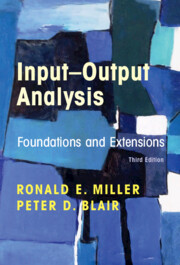2 results
6 - Multipliers in the Input–Output Model
-
- Book:
- Input-Output Analysis
- Published online:
- 06 January 2022
- Print publication:
- 13 January 2022, pp 238-288
-
- Chapter
- Export citation

Input-Output Analysis
- Foundations and Extensions
-
- Published online:
- 06 January 2022
- Print publication:
- 13 January 2022

